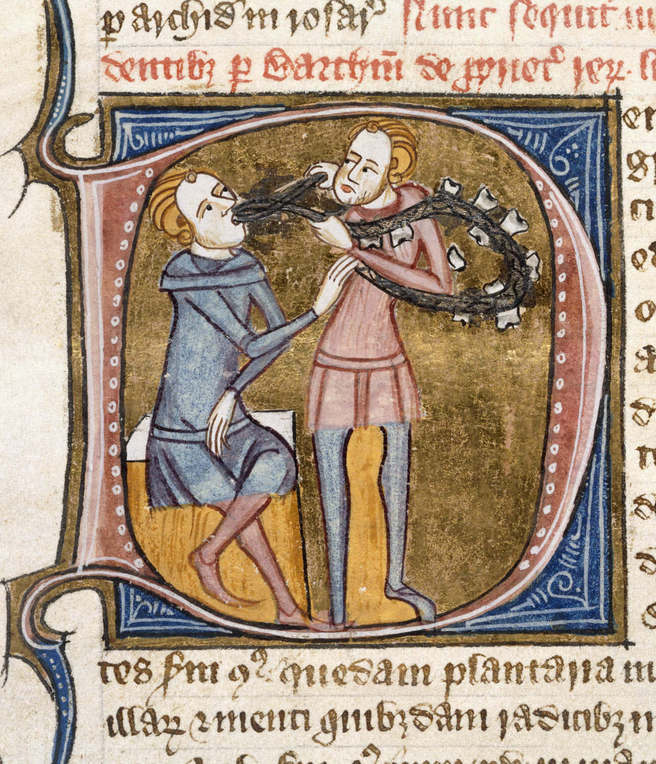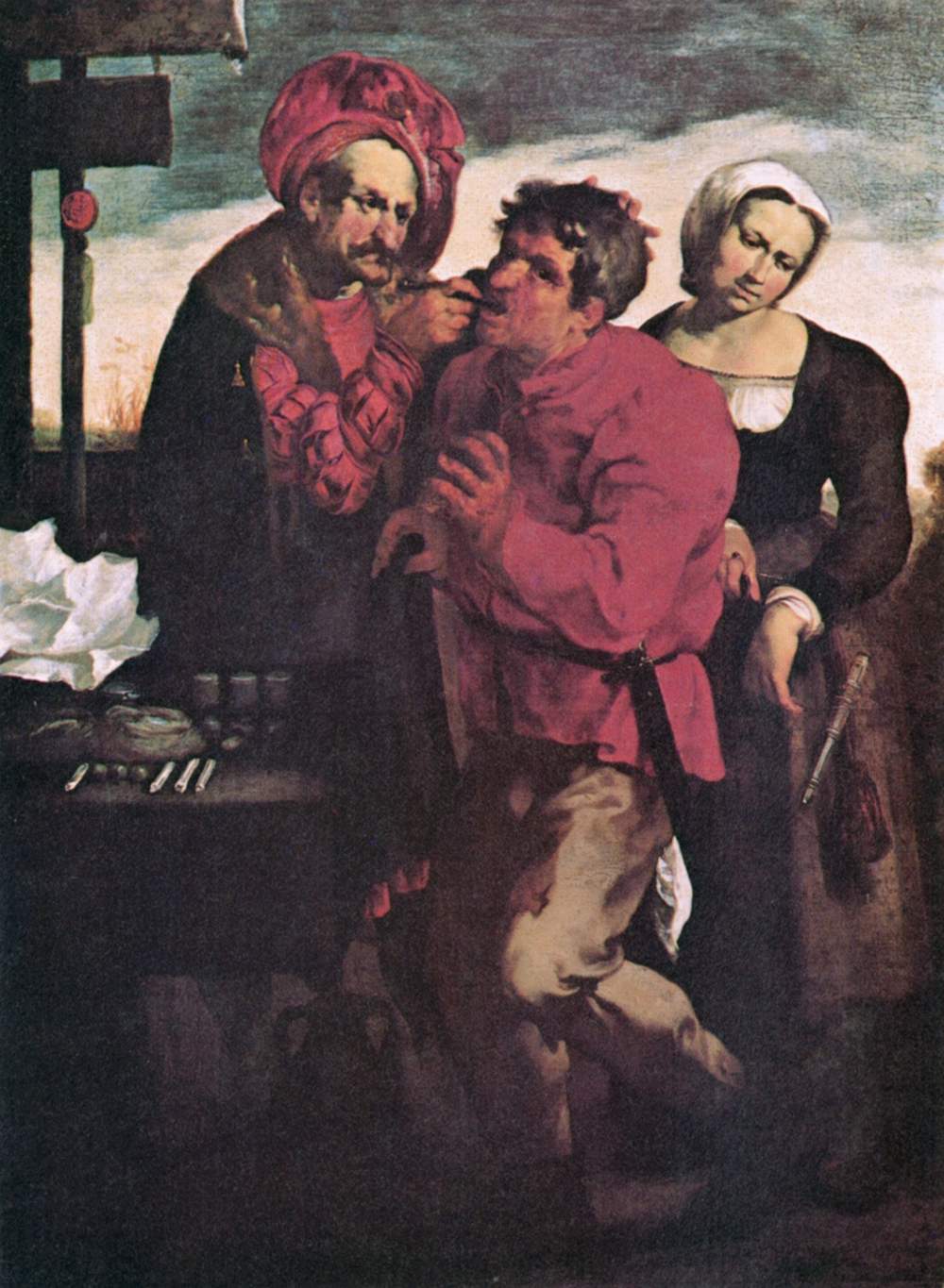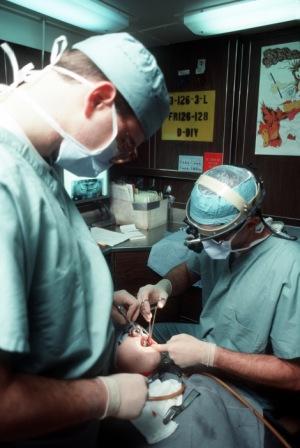Dentistry
 From Wikidoc - Reading time: 8 min
From Wikidoc - Reading time: 8 min

|
WikiDoc Resources for Dentistry |
|
Articles |
|---|
|
Most recent articles on Dentistry |
|
Media |
|
Evidence Based Medicine |
|
Clinical Trials |
|
Ongoing Trials on Dentistry at Clinical Trials.gov Clinical Trials on Dentistry at Google
|
|
Guidelines / Policies / Govt |
|
US National Guidelines Clearinghouse on Dentistry
|
|
Books |
|
News |
|
Commentary |
|
Definitions |
|
Patient Resources / Community |
|
Patient resources on Dentistry Discussion groups on Dentistry Directions to Hospitals Treating Dentistry Risk calculators and risk factors for Dentistry
|
|
Healthcare Provider Resources |
|
Causes & Risk Factors for Dentistry |
|
Continuing Medical Education (CME) |
|
International |
|
|
|
Business |
|
Experimental / Informatics |
Editor-In-Chief: C. Michael Gibson, M.S., M.D. [1]
Overview[edit | edit source]
Dentistry is the "evaluation, diagnosis, prevention and/or treatment (nonsurgical, surgical or related procedures) of diseases, disorders and/or conditions of the oral cavity, maxillofacial area and/or the adjacent and associated structures and their impact on the human body".[1] Those in the practice of dentistry are known as dentists. Other people aiding in oral health service include dental assistants, dental hygienists, dental technicians, and dental therapists.
A dentist is a healthcare professional qualified to practice dentistry after graduating with a degree of either Doctor of Dental Surgery (DDS), Doctor of Dental Medicine (DMD), Bachelor of Dentistry (BDent), Bachelor of Dental Science (BDSc), or Bachelor of Dental Surgery/Chirurgiae (BDS) or (BChD) or equivalent. In most western countries, to become a qualified dentist one must usually complete at least 4 years of postgraduate study. Generally, 2 years of clinical experience working with patients in an educational setting are required. While in most countries, dentists neither earn a Doctorate degree, or medical degree, they are afforded the honorary title "Doctor".[2]
History[edit | edit source]
Evidence of dentistry has been found in teeth dating from around 5500 BC to 7000 BC.[3][4] The teeth, showing evidence of holes from dental drills, were found in people of the Indus Valley Civilization.[5] A Sumerian text from 5000 BC describes a "tooth worm" as the cause of dental caries.[6] Evidence of this belief has also been found in India, Egypt, Japan, and China.[7]
The Edwin Smith Papyrus, written in the 17th century BC but which may reflect previous manuscripts from as early as 3000 BC, includes the treatment of several dental ailments.[8][9] In the 18th century BC, the Code of Hammurabi referenced dental extraction twice as it related to punishment.[10] Examination of the remains of some ancient Egyptians and Greco-Romans reveals early attempts at dental prosthetics and surgery.[2]
Historically, dental extractions have been used to treat a variety of illnesses. During the Middle Ages and throughout the 19th century, dentistry was not a profession in itself, and often dental procedures were performed by barbers or general physicians. Barbers usually limited their practice to extracting teeth, which not only resulted in the alleviation of pain, but often cured a variety of ailments linked to chronic tooth infection. Instruments used for dental extractions date back several centuries. In the 14th century, Guy de Chauliac invented the dental pelican[3] (resembling a pelican's beak) which was used up until the late 18th century. The pelican was replaced by the dental key[4] which, in turn, was replaced by modern forceps in the 20th century.
The first book focused solely on dentistry was the "Artzney Buchlein" in 1530, and the first dental textbook written in English was called "Operator for the Teeth" by Charles Allen in 1685.[11] It is said that the 17th century French physician Pierre Fauchard started dentistry science as we know it today, and he has been named "the father of modern dentistry". Among many of his developments were the extensive use of dental prosthesis, the introduction of dental fillings as a treatment for dental caries and the statement that sugar derivate acids such as tartaric acid are responsible for dental decay.
The Baltimore College of Dental Surgery, the first dental school in the world, opened in Baltimore, Maryland in 1840, and in 1867 Harvard Dental School became the first dental school affiliated with a university. In England, the 1878 British Dentists Act and 1879 Dentists Register limited the title of "dentist" and "dental surgeon" to qualified and registered practitioners.[12][11] The practice of dentistry in the United Kingdom became fully regulated with the 1921 Dentists Act, which required the registration of anyone practicing dentistry.[13] The British Dental Association, formed in 1880 with Sir John Tomes as president, played a major role in prosecuting dentists practicing illegally.[12]
-
Medieval dentist extracting a tooth. London; c. 1360-75.
-
Farmer at the dentist, Johann Liss, c. 1616-17.
-
A Dentist and Dental Assistant perform surgery on a patient.
General dentistry[edit | edit source]
General practitioners of dentistry prevent, evaluate, diagnose, and treat diseases of the oral cavity and associated structures (e.g. the temporomandibular joint), as well as maintain the functionality and esthetics of the teeth and associated tissues and structures. They can prescribe drugs, x-rays, and devices for home or in-office use. Many oral diseases (such as bilateral odontogenic keratocysts) and abnormalities (such as several unerupted teeth) can indicate systemic, neural, or other diseases. A general practitioner may refer patients to their physician or a specialist for further evaluation, or vice versa for treatment.
Contrary to popular belief, most dentists do not regularly clean teeth, and instead delegate this task to other oral health providers (e.g. dental hygienists). Most general practitioners of dentistry perform restorative, prosthetic, routine endodontic therapy, routine periodontal therapy, and simple exodontia, as well as performing examinations. General practitioners can choose which cases to treat, and which will be referred to a specialist for further care. Many general practitioners are comfortable treating more complex cases, as well as placing implants and surgically extracting third molars(wisdom teeth). All dentists must achieve a certain degree of skill in various disciplines in order to graduate from dental school and earn licensure. Many complex procedures are frequently referred to specialists.
Effectiveness[edit | edit source]
A 2008 review in the Journal of Dentistry concluded "While laboratory studies suggest a promising potential of ozone in dentistry, this has not been fully realised in clinical studies to date. More well designed and conducted double-blind randomised clinical trials with adequate sample size, limited or no loss to follow up, and carefully standardised methods of measurement and analyses are needed to evaluate the possible use of ozone as a treatment modality in dentistry."[14]
Specialities[edit | edit source]
In addition to general dentistry, there are 9 recognized dental specialties in the US, Canada, and Australia. To become a specialist requires one to train in a residency or advanced graduate training program. Once residency is completed, the doctor is granted a certificate of specialty training. Many specialty programs have optional or required advanced degrees such as (MD/MBBS specific to Maxillofacial Surgery), MS, or PhD.
- Dental public health (study of dental epidemiology and social health policies),
- Endodontics (root canal therapy and study of diseases of the dental pulp),
- Oral and Maxillofacial Pathology (study, diagnosis, and sometimes the treatment of oral and maxillofacial related diseases),
- Oral and Maxillofacial Radiology (study and radiologic interpretation of oral and maxillofacial diseases),
- Oral and Maxillofacial Surgery (extractions, facial surgery and implants),
- Orthodontics and Dentofacial Orthopaedics (straightening of teeth and modification of midface and mandibular growth),
- Anesthesiology study how to relieve pain through advanced use of local and general anesthesia techniques
- Periodontics (study and treatment of diseases of the periodontium (non-surgical and surgical), and placement and maintenance of dental implants),
- Pediatric Dentistry (i.e. dentistry for children, formerly known as "pedodontics"),
- Prosthodontics (dentures, bridges and the restoration of implants. Some prosthodontists further their training in "oral and maxillofacial prosthodontics--a discipline concerned with the replacement of missing facial structures--such as ears, eyes, nose, etc.)
Specialists in these fields are designated registrable (U.S. "Board Eligible") and warrant exclusive titles such as orthodontist, oral and maxillofacial surgeon, endodontist, pediatric dentist, periodontist, or prosthodontist upon satisfying certain local (U.S. "Board Certified"), (Australia/NZ: "FRACDS"), or (Canada: "FRCD(C)") registry requirements.
Two other post-graduate formal advanced education programs: General Practice Residency (advanced clinical and didactic training with intense hospital experience) and Advanced Education in General Dentistry (advanced training in clinical dentistry) recognized by the ADA do not lead to specialization.
Special category: Oral Biology - Research in Dental and Craniofacial Biology
Other dental education exists where no post-graduate formal university training is required: cosmetic dentistry, dental implant, temporo-mandibular joint therapy. These usually require the attendance of one or more continuing education courses that typically last for one to several days. There are restrictions on allowing these dentists to call themselves specialists in these fields. The specialist titles are registrable titles and controlled by the local dental licensing bodies.
Forensic odontology consists of the gathering and use of dental evidence in law. This may be performed by any dentist with experience or training in this field. The function of the forensic dentist is primarily documentation and verification of identity.
Geriatric dentistry or geriodontics is the delivery of dental care to older adults involving the diagnosis, prevention, and treatment of problems associated with normal ageing and age-related diseases as part of an interdisciplinary team with other health care professionals.
Veterinary dentistry, a speciality of veterinary medicine, is the field of dentistry applied to the care of animals [5][6].
Dentistry throughout the world[edit | edit source]
Organizations[edit | edit source]
See also[edit | edit source]
- Biodontics
- Bruxism
- Calculus
- Ceramics
- Crown
- Dental amalgam
- Dental brace
- Dental cavities
- Dental notation
- Dental spa
- Dental extraction
- Dentin
- Dental restoration
- Floss
- Fluoridation
- Fluoride therapy
- Gingivitis
- Halitosis
- Dental implants
- Laboratory technology
- Mouthwash
- Nitrous oxide
- Novocain, a Local anesthetic
- Occlusion
- Oral hygiene
- Orthodontics
- Patron Saint of dentistry (Saint Apollonia)
- Periodontitis
- Periodontology or Periodontics
- Plaque
- Regenerative dentistry
- Teledentistry
- Temporomandibular joint disease
- Tooth
- Toothbrush
- Toothpaste
- Xerostomia
- Dental phobia
- Dental fear
Lists[edit | edit source]
References[edit | edit source]
- ↑ Dentistry Definitions, hosted on the American Dental Association website. Page accessed December 11, 2007. This definition was adopted the association's House of Delegates in 1997.
- ↑ Dentists in the UK to use courtesy title doctor (Dr) Dentists in the UK should be referred to by the courtest title doctor.
- ↑ Stone age man used dentist drill, hosted on the BBC News website. Last updated April 6, 2006. Page accessed December 11, 2007.
- ↑ Dig uncovers ancient roots of dentistry: Tooth drilling goes back 9,000 years in Pakistan, scientists say, hosted on the MSNBC website. Page accessed on January 10, 2007.
- ↑ Coppa, A. et al. 2006. "Early Neolithic tradition of dentistry: Flint tips were surprisingly effective for drilling tooth enamel in a prehistoric population." Nature. Volume 440. 6 April, 2006.
- ↑ History of Dentistry: Ancient Origins, hosted on the American Dental Association website. Page accessed January 9, 2007.
- ↑ Suddick, Richard P. and Norman O. Harris. "Historical Perspectives of Oral Biology: A Series". Critical Reviews in Oral Biology and Medicine, 1(2), pages 135-151, 1990.
- ↑ Arab, M. Sameh. Medicine in Ancient Egypt. Page accessed December 15, 2007.
- ↑ Ancient Egyptian Dentistry, hosted on the University of Oklahoma website. Page accessed December 15, 2007.
- ↑ Wilwerding, Terry. History of Dentistry, hosted on the Creighton University School of Dentistry website, page 4. Page accessed December 15, 2007.
- ↑ 11.0 11.1 The story of dentistry: Dental History Timeline, hosted on the British Dental Association website. Page accessed December 11, 2007.
- ↑ 12.0 12.1 Gelbier, Stanley. 125 Years of Developments in Dentistry. British Dental Journal (2005); 199, 470-473. Page accessed December 11, 2007. The 1879 register is referred to as the "Dental Register".
- ↑ History of Dental Surgery in Edinburgh, hosted on the Royal College of Surgeons of Edinburgh website. Page accessed December 11, 2007.
- ↑ Azarpazhooh A, Limeback H (2008). "The application of ozone in dentistry: a systematic review of literature". J Dent. 36 (2): 104–16. doi:10.1016/j.jdent.2007.11.008. PMID 18166260.
External links[edit | edit source]
- History of Dentistry in the 20th Century by the ADA
- Information resource for UK dental professionals
- Ancient dentistry discovered
- Template:Dmoz
|
Cleft lip and palate Microchapters |
|
Diagnosis |
|---|
|
Treatment |
|
Case Studies |
|
Dentistry On the Web |
|
American Roentgen Ray Society Images of Dentistry |
Template:Allied health professions
ar:طب أسنان
az:Stomatologiya
zh-min-nan:Gê-i-ha̍k
ca:Odontologia
cs:Stomatologie
da:Tandlæge
de:Zahnmedizin
el:Οδοντιατρική
eo:Dentkuracado
eu:Odontologia
ko:치과
hr:Stomatologija
id:Kedokteran gigi
iu:ᑭᒍᑎᓕᕆᔨ/kigutiliriji
is:Tannlækningar
it:Odontoiatria
he:רפואת שיניים
hu:Fogászat
ml:ദന്തരോഗവിദഗ്ദ്ധന്
nl:Tandheelkunde
no:Odontologi
qu:Kiru hampikamayuq
simple:Dentistry
sl:Dentalna medicina
sr:Стоматологија
fi:Hammaslääketiede
sv:Tandvård
uk:Стоматологія
Template:Jb1
Template:WH
Template:WS
 KSF
KSF

